Example: How to model complex power system faults
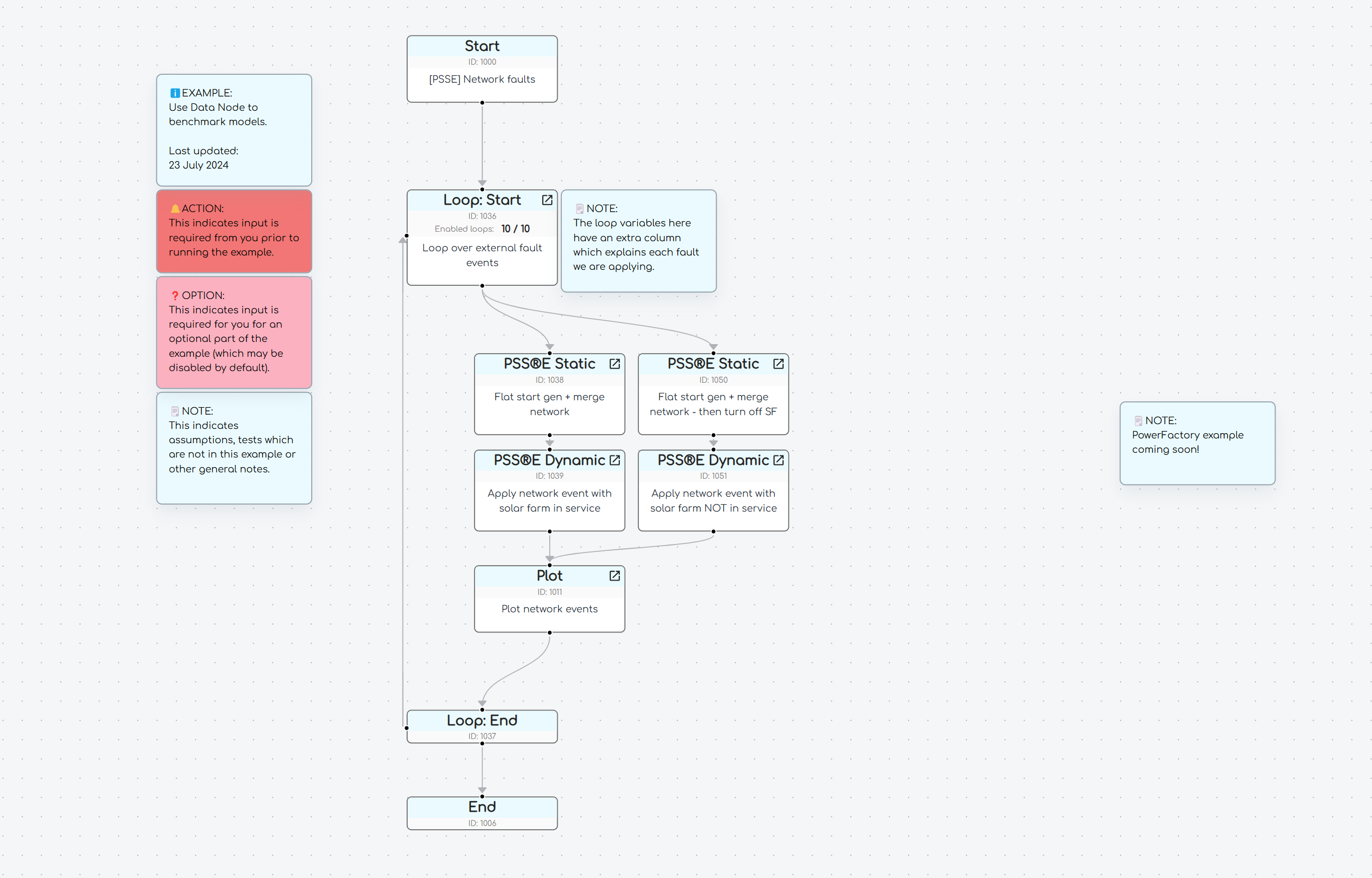
Last updated: 23 July 2024
Software required:
Background
Example file to demonstrate how to use gridmo's ADVFAULT command and automatic PSS®E model-merge to model complex power system faults on large networks.
Tutorial
Commonly, once single machine infinite bus (SMIB) tests are completed, the model of a generating system is merged into a wide-area dynamic network model to investigate the generating system's response when connected to other generation.
As part of these studies, complex network faults are often simulated to test the generating system's response to various network disturbances.
In this example we will show you how to model complex network faults such as auto-reclose, control trips, run-backs and intertrips using gridmo.
| Event type | Description |
|---|---|
| Auto-reclose (ARC) | A fault is applied to a network asset (usually an overhead line), the line is tripped and then automatically closes back into service after a fixed delay. This is because the fault may no longer be present, such as a tree branch which fell onto a line but then fell off shortly afterwards. Multiple reclose attempts can be made before the line 'locks-out' (is disconnected pending human intervention) |
| Control trip | A network asset is disconnected when a fault is not present, equivalent to a control room operator manually disconnecting a line. |
| Run-back scheme | A network asset is disconnected (either with or without a fault) which triggers a special protection scheme. This system instructs one or more generator(s) to 'run-back' their active power to a predefined level, which may be 0 MW. Generators which have been run-back still provide voltage support (they are not disconnected).Typically used to prevent thermal overloads on network assets. |
| Intertrip scheme | A network asset is disconnected (either with or without a fault) which triggers a special protection scheme. This system instructs one or more generator(s) to immediately disconnect from the network. Typically used to prevent grid-following generating systems from operating in a network with insufficient fault level (system strength). |
Note there are additional faults in the downloadable example file (above) which are not covered in this page, such as:
- A line fault with multi-shot unsuccessful auto-reclose.
- Simulating circuit breaker failures by tripping buses at the end of a line fault.
- Simulating two line faults at the same time, forming an electrical island which is disconnected.
In the following tutorial, we will:
- Auto-merge a PSS®E SMIB model of a generator into a PSS®E network model.
- Once merged, run a dynamic study and apply several complex network events/faults.
- Plot the results of each network event.
The following example assumes you have a basic understanding of the gridmo platform. If you are new to gridmo, please see the Getting started guide.
1) Start a new gridmo Project and add the following Nodes
StartNodeLoop StartNodePSS®E StaticNodePSS®E DynamicNodePlotNodeLoop EndNodeEndNode
Connect the Nodes so they appear as follows:

2) Set up auto-merge for the PSS®E Static Node
- Double click on the
PSS®E StaticNode to open the configuration window. - Set the
Modeltogridmo\wecc-solar\psse\solar.savto use an example 175 MW solar farm's PSS®E case file. - Select the
Define simulation & Define outputstab.- In the
Customize gridfield selectMerge into network - Set the
Network modelfield togridmo\distnet\distnetworkexample.savto use an example network model with several pre-configured generators. - To merge bus number
1000in the SMIB model with bus number34502in the network model, set:- The
Model: Bus numberfield to1000 - The
Network model: Bus numberfield to34502
- The
- In the
- Under the
Commandsfield, add the following Commands:
// Set POC P and V - then apply all CONTROL Commands at the same time
CONTROL, GEN=91003#S1, ATLINE=1001->1000#1, P=175
CONTROL, GEN=91003#S1, ATLINE=1001->1000#1, Q=FIXED, QTARGET=0
SOLVE
// No need to set SCR or XR as we are merging into a network case, and POC V is dictated by the network model
- The above Commands control our example solar farm to achieve P=175 MW, Q=0 MVAr at the solar farm's connection point after it has been merged into the network model.
3) Create Loop Variables in the Loop Start Node
- We are going to apply a series of network faults which we want to loop over. We could create multiple
PSS®E StaticandPSS®E DynamicNodes - however it is easier to use aLoop StartNode. - Double click on the
Loop StartNode to open the configuration window. - Click the
+button (far right hand side) to add a new Loop Variable. - Add a Loop Variable called
l_event_descriptionand a second Loop Variable calledl_eventtipThe
l_is optional, but recommended, as it'll help you remember that these are Loop Variables. - Delete the existing example Loop Variable called
l_new_variable_1using the trash can icon next to its name. - Delete the empty rows using the trash can icon next to the empty row, leaving one empty row.
- Click Apply (we will add events one at a time once we are all set up).
4) Configure the PSS®E Dynamic Node
- Double click on the
PSS®E DynamicNode to open the configuration window. - Select the tickbox to enable
Use model from linked PSS®E Static Node - Set the
Dynamics model datatogridmo\wecc-solar\psse\solar.dyrto use an example 175 MW solar farm's PSS®E dynamic data record. - Select the
Define simulationtab.- In the
Customize gridfield selectMerge into network - Set the
Network dynamics model datatogridmo\distnet\distnet_dyr.dyrto load the dynamic data records for all the generators in the example network model.
- In the
- Under the
Commandsfield, add the following Commands:
// Put solar farm in V control mode (see PSSE Model PDF docs for ICON reference)
CONTROL, AT=0, ICON=M+5, GEN=91003#S1, DYRMODEL=REPCA1, VAL=1
// Set initial P at POC
CONTROL, AT=0, VAR=L+3, GEN=91003#S1, DYRMODEL=REPCA1, VAL=1, VALSCALE=0.875
// Apply the network event defined in the Loop Variable
$l_event
- The above Commands:
- Put the solar farm in voltage control mode
- Set the initial active power at the point of connection (POC) to
175MW . - Apply the network event defined in the Loop Variable
l_event.
- In the
Define outputstab, set theOutputsfield to the following:
// Values from our generator
OUTPUT, BUS=1000, VAL=V, NAME=i_ch_poc_v
OUTPUT, LINE=1001->1000#1, VAL=P, NAME=i_ch_poc_p
OUTPUT, LINE=1001->1000#1, VAL=Q, NAME=i_ch_poc_q
OUTPUT, BUS=91003, VAL=V, NAME=i_ch_terminal_v
// Values from network
OUTPUT, BUS=34501, VAL=V, NAME=i_ch_v_34501
OUTPUT, BUS=34502, VAL=V, NAME=i_ch_v_34502
- The above Commands output:
- V, P and Q at our generators connection point.
- V and two ends of a line we will apply the complex faults on.
5) Configure the Plot Node
- Double click on the
PlotNode to open the configuration window. - Set the
Plot typetoPDFto output a PDF file. - Enter an output file name, such as
Applying complex network events. - Enter a plot title, such as
Applying complex network events. - For the plot subtitle, enter
$l_event_descriptionto display the description of the network event being applied as defined in thel_event_descriptionLoop Variable. - In the
Define Subplotstab:- Set the x-axis minimum
0and maximum to20 - Under
Subplotsselect1page,3rows and2columns. - Click on the
+to add a new subplot. For each subplot:- Enter a title in
Subplot title, such asV at ABC 345 kV (Bus #34501)etc. - Under
y-axis Channelsenter each of the Internode Variables with the double curly brackets, such as{{i_ch_poc_v}}
- Enter a title in
- Add 6 subplots in total (or as many as you wish to investigate) entering the Internode Variable reference from the
PSS®E Dynamicnode above.
- Set the x-axis minimum
We now have our gridmo project set up to apply complex network events.
Advanced examples
The following are additional examples covering a variety of different network events/faults/
Simulating a line fault without auto-reclose
We want to simulate the following event in our dynamic study:
- There is a fault on the line between PSS®E bus
34501and34502. - The fault is very close to bus
34501(10% of the line length from bus34501). - The fault is a three-phase fault.
- The line is disconnected by a protection relay at the bus
34501end after80ms. - The line is disconnected by a protection relay at the bus
34502end after220ms. - The line is out of service then for the rest of the simulation. No auto-reclose is attempted.
To implement this event:
- Double click on the
Loop StartNode to open the configuration window. - In the empty row under
l_event_descriptionenter (or add another row using the+ Add Loopbutton):
Bolted 3PH fault 10% from ABC on ABC to XYZ No.1 345 kV line (Near 80 ms, far 220 ms, line out after fault).
- In the empty row under
l_evententer:
ADVFAULT, AT=5, TYPE=3PH, LINE=34501->34502#1, DURATION1=80, DURATION2=220, DISTANCE%=10
You can then launch the simulation (making sure the checkbox next to your new row in the Loop Start Node is ticked) and review the results:
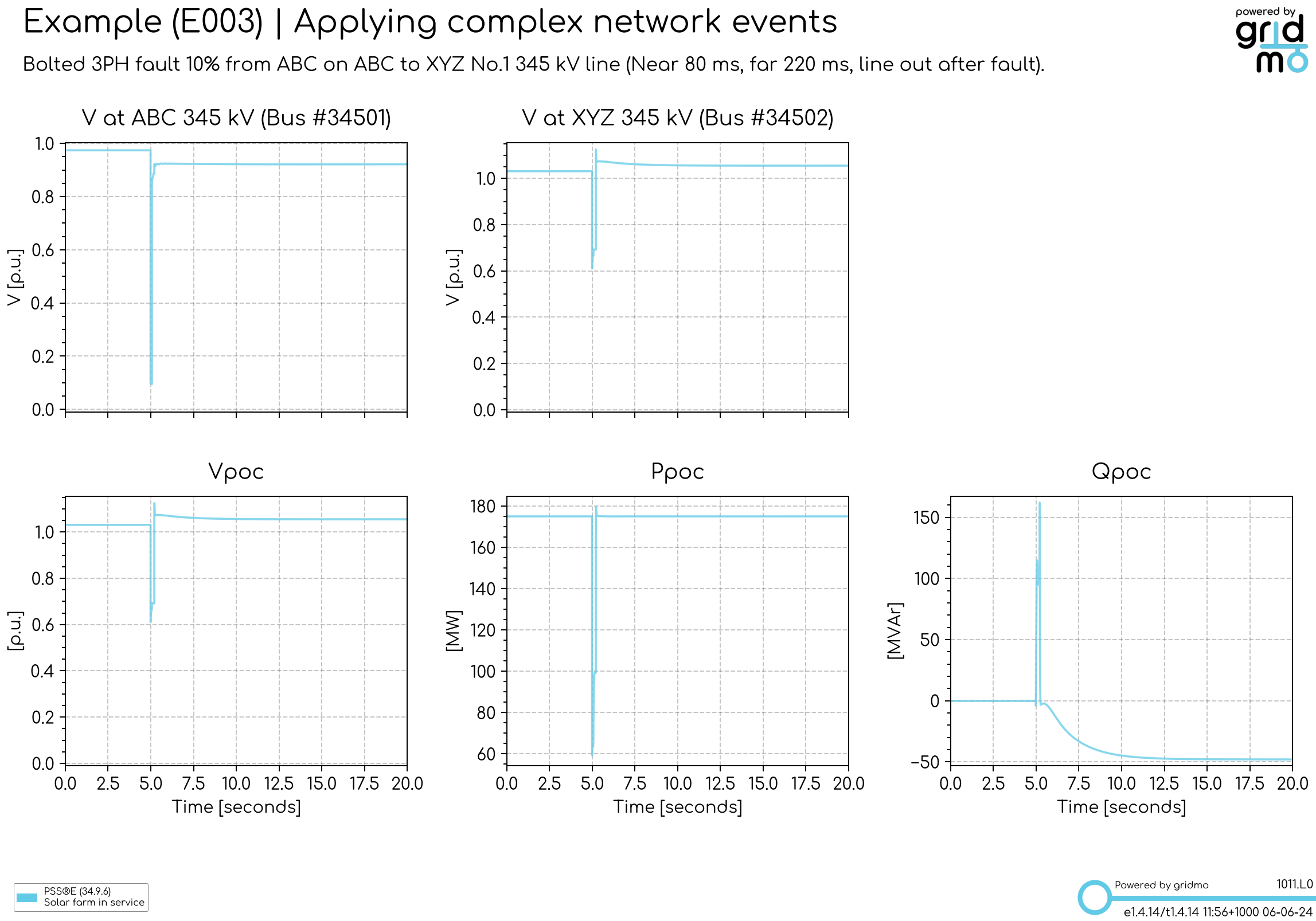
In the above plot, we can see the following:
- The voltage at both ends of the line is affected by the fault.
- The voltage dips to lower at the bus
34501end of the line, as the fault is closer to this bus. - The fault is cleared quicker from the bus
34501end of the line than the bus34502end of the line as expected. - The line is out of service for the rest of the simulation (we can tell that by the change in the voltage profile at the bus
34501and34502ends of the line).
Simulating a line fault with auto-reclose
For our second event, we want the same line fault except now the line auto-recloses sucessfully after 3 seconds.
To implement this event:
- Double click on the
Loop StartNode to open the configuration window. - In the empty row under
l_event_descriptionenter (or add another row using the+ Add Loopbutton):
Bolted 3PH fault 10% from ABC on ABC to XYZ No.1 345 kV line (Near 80 ms, far 220 ms, line recloses after 3 sec).
- In the empty row under
l_evententer:
ADVFAULT, AT=5, TYPE=3PH, LINE=34501->34502#1, DURATION1=80, DURATION2=220, DISTANCE%=10, AR_RETRIES=1, AR_FINALSTATE=IN, AR_DEADTIME=3000
The difference between this Command and the one previously is the addition of the auto-reclose optional arguments: AR_RETRIES=1, AR_FINALSTATE=IN, AR_DEADTIME=3000 - meaning retry once, after all retries the line is in service and with a dead time of 3 seconds (3000 milliseconds).
gridmo by default implements auto-reclose logic assuming the tobus (which is 34502 in our example) has dead-line blocking enabled. That is, only the frombus end of the line will attempt to auto-reclose and only if its a successful auto-reclose, the tobus end will close.
This is to mimic the typical configuration of protection relays (to prevent unnecessary reclose attempts on a line which has a fault).
However - this performance is customisable, see the ADVFAULT Command
You can then launch the simulation (making sure the checkbox next to your new row in the Loop Start Node is ticked) and review the results:
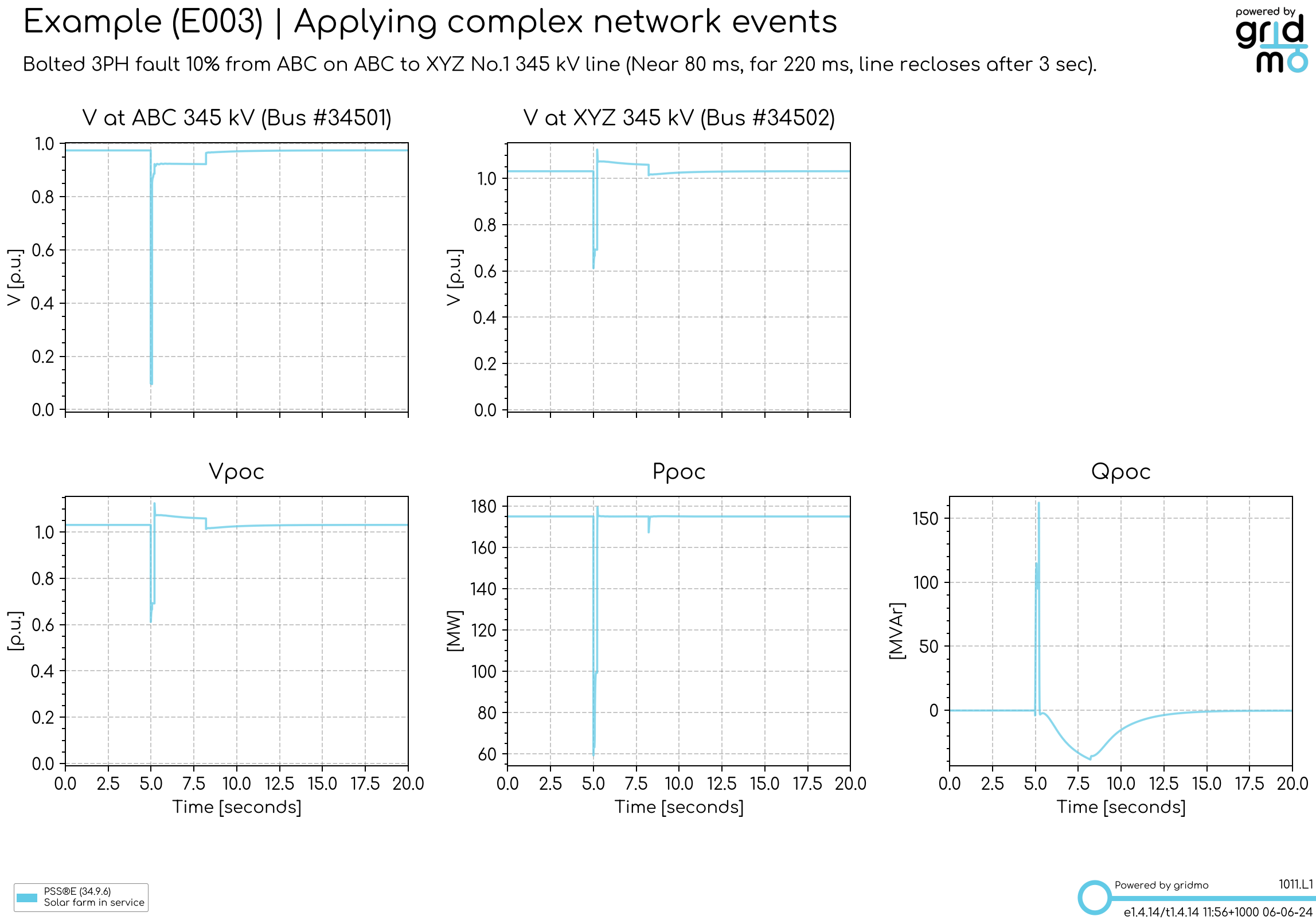
In the above plot, we can see the following:
- The line switches back in service at approximately 8 seconds in the simulation.
- We can see our solar farm ramping back to its pre-disturbance reactive power once the line is reclosed.
Simulating a line control trip
Now we want simulate a control trip, the sudden disconnection of a line without a fault present. Specifically we want:
- The line from bus
34501to34502to be disconnected by a control room operator after5seconds in the simulation. No fault is present.
To implement this event:
- Double click on the
Loop StartNode to open the configuration window. - In the empty row under
l_event_descriptionenter (or add another row using the+ Add Loopbutton):
Control trip of ABC to XYZ No.1 345 kV line (line disconnects without fault).
- In the empty row under
l_evententer:
SET, AT=5, LINE=34501->34502#1, STATUS=OUT
You can then launch the simulation (making sure the checkbox next to your new row in the Loop Start Node is ticked) and review the results:
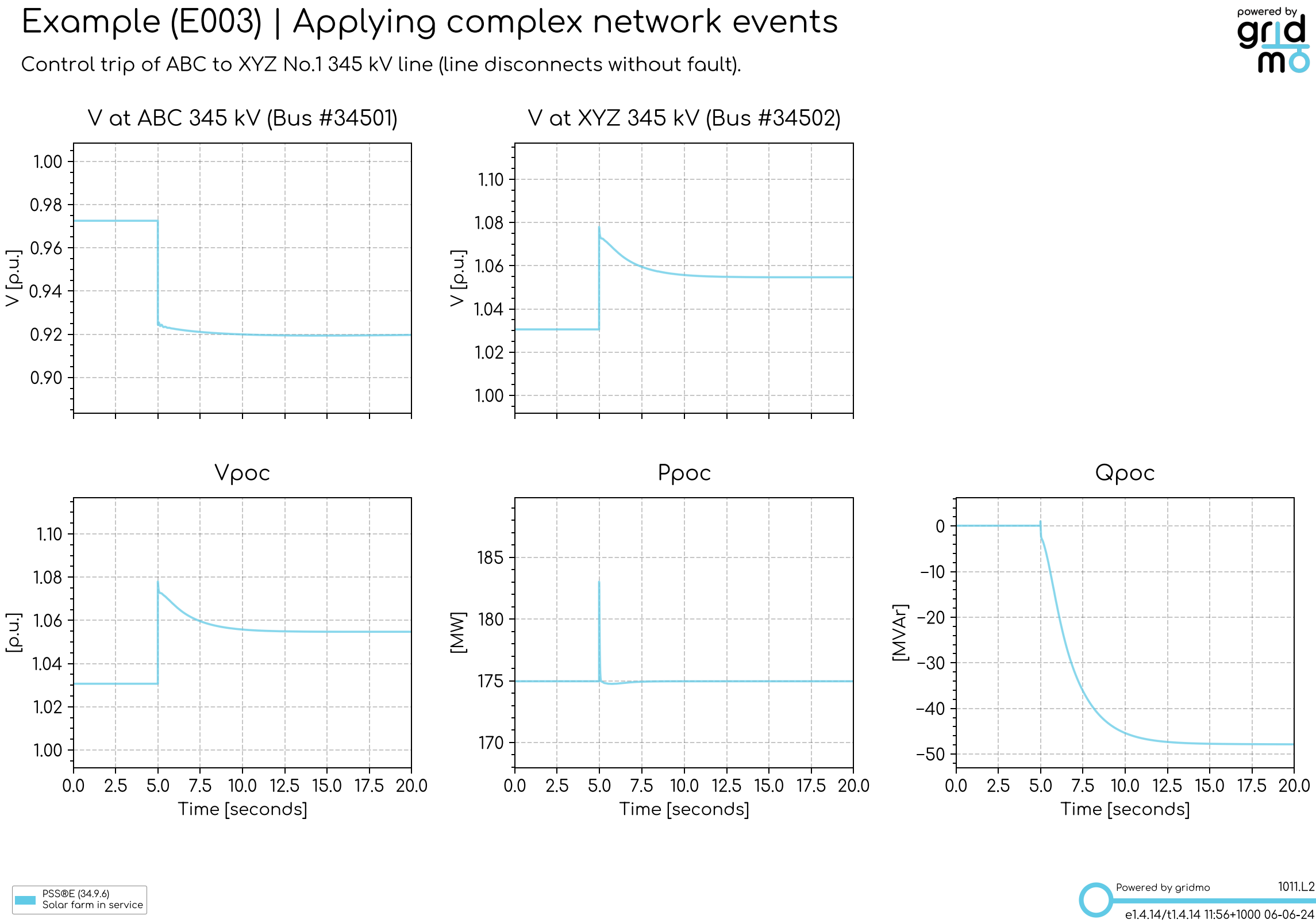
In the above plot, we can see the following:
- The line switches out at 5 seconds (we can see a difference in the voltages of bus
34501and34052). - We can see our solar farm responding to the change in network conditions by changing its reactive power output.
Simulating a run-back scheme triggered by a line control trip
Now we want simulate a run-back scheme, the disconnection of a line which triggers a generator to run-back its active power to 0 MW. Specifically:
- The line from bus
34501to34502is disconnected at5seconds in the simulation. No fault is present. - The solar farm is instructed to run-back its active power to
0MW after a delay of2seconds.
To implement this event:
- Double click on the
Loop StartNode to open the configuration window. - In the empty row under
l_event_descriptionenter (or add another row using the+ Add Loopbutton):
Control trip of ABC to XYZ No.1 345 kV line (line disconnects without fault, triggers run-back after 2 sec).
- In the empty row under
l_evententer (use Shift+Enter to add multiple lines)
SET, AT=5, LINE=34501->34502#1, STATUS=OUT
CONTROL, AT=7, VAR=L+3, GEN=91003#S1, DYRMODEL=REPCA1, VAL=0 // run-back our solar farm to 0 MW

In the above plot, we can see the following:
- The line switches out at 5 seconds (we can see a difference in the voltages of bus
34501and34052). - The solar farm reacts immediately to the change in network conditions by ramping its reactive power.
2seconds after the fault, the solar farm ramps its active power output to0MW as per the run-back scheme.
Simulating an intertrip scheme
Now we want to simulate an intertrip scheme, the disconnection of a line which triggers a generator to immediately disconnect from the network. Specifically:
- The line from bus
34501to34502is disconnected at5seconds in the simulation. No fault is present. - The solar farm is instructed to immediately disconnect from the network after the line is disconnected.
To implement this event:
- Double click on the
Loop StartNode to open the configuration window. - In the empty row under
l_event_descriptionenter (or add another row using the+ Add Loopbutton):
Control trip of ABC to XYZ No.1 345 kV line (line disconnects without fault, triggers intertrip).
- In the empty row under
l_evententer (use Shift+Enter to add multiple lines)
SET, AT=5, LINE=34501->34502#1, STATUS=OUT
SET, AT=5.42, GEN=91003#S1, STATUS=OUT
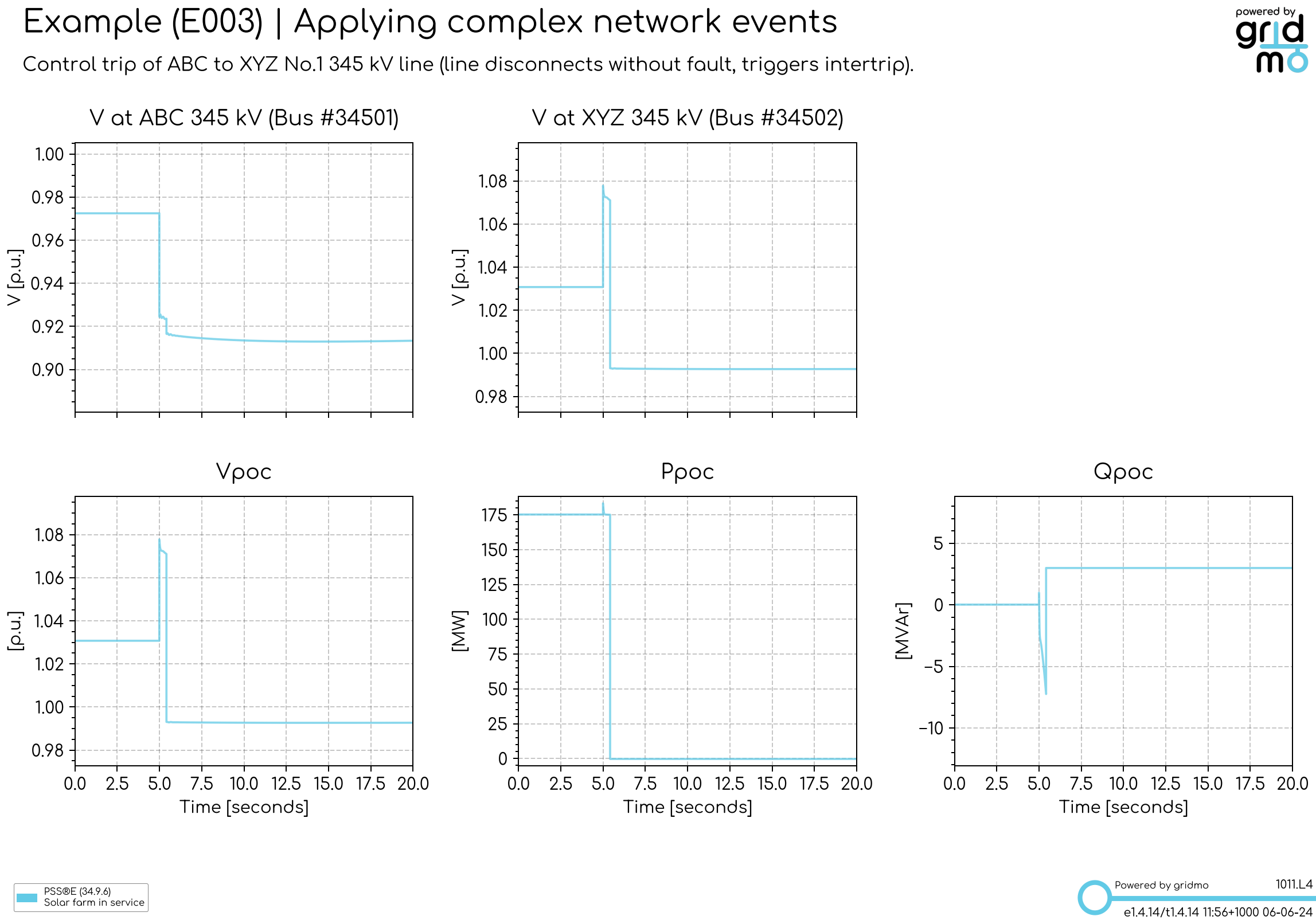
In the above plot, we can see the following:
- The line switches out at 5 seconds (we can see a difference in the voltages of bus
34501and34052). - The solar farm disconnects at the end of the fault (point of connection P drops to
0MW immediately).
Revision history
- v1.4.15.6 (23 July 2024)
- Updated Sticky Node helper text in example.
- v1.4.15 (20 June 2024)
- First release of example file.